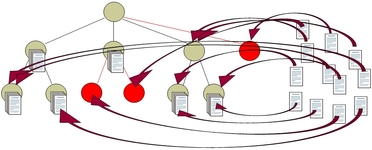Information Structuring and Organisation
 The exploration of a data collection for possibly interesting information can be a tedious task. Hierarchical structures can help in locating interesting objects, especially if the collection is unknown to the searcher. However, for each collection there are several "meaningful" ways to structure it. This is especially true when dealing with high dimensional data like text documents. Here, users can have different perspectives, which depend on their knowledge, interests, context etc. A structuring fitting to the specific user is essential, if we want to support the user successfully in identifying objects of interest.
The exploration of a data collection for possibly interesting information can be a tedious task. Hierarchical structures can help in locating interesting objects, especially if the collection is unknown to the searcher. However, for each collection there are several "meaningful" ways to structure it. This is especially true when dealing with high dimensional data like text documents. Here, users can have different perspectives, which depend on their knowledge, interests, context etc. A structuring fitting to the specific user is essential, if we want to support the user successfully in identifying objects of interest.
Our research in the area of information structuring deals with finding hierarchical structures, especially structures that reflect the way a user would structure the collection of objects at hand. Therefore, some information on how the user structures the data is required. One way to tackle this problem is to assume that some already filed documents stored into a hierarchical structure are available, e.g. in a personalized desktop environment, a file system, or a bookmark structure. This gives us implicit knowledge about the users structuring criteria. Of course, these hierarchies cover most likely only a very small part of the - to the user yet unknown - collection that should be structured. This is important for defining the learning task as it makes standard classification methods unsuitable for solving this problem. Some recent works in this area are listed below.
Selected Publications
- Korinna Bade and Andreas Nürnberger, Personalized Hierarchical Clustering, in: Toyoaki Nishida (Hrsg.), Proc. of IEEE/WIC/ACM International Conference on Web Intelligence (WI-06), pp.: 181-187, IEEE Computer Society Press, 2006.
- Korinna Bade and Andreas Nürnberger, Creating a Cluster Hierarchy under Constraints of a Partially Known Hierarchy, Proceedings of the 2008 SIAM International Conference on Data Mining, 2008.
